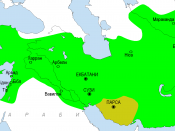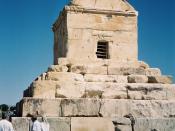By the 6th cent BC the early Persians were established in the present-day region of Fars and were benefiting from the decline of Elam. Fars (Persis to the Greeks) was a recognizable district of the Assyrian Empire like the neighboring but larger Media. The Persian rulers, claiming descent from one Achaemenes, were associated with the Medes, who created a strong state in the 7th century. Cyaxares, son of Phraortes, the founder of Median power, was one of the kings who brought about the fall of Nineveh (612 BC) and broke the control of the Assyrians. The Persian ruler of about the same time, Cambyses I, would marry the daughter of the Median ruler Astyages (Cyaxares' son), and his son Cyrus was thus also grandson of Cyaxares. This join with the Medes gave the Persians the strong standpoint they needed in the near Middle East up until early/mid 4th century in order for them to expand in the manner they did.
However, a common factor in the premature fall of empires is that they have been often set up to quickly, this is the case with the Persian Empire as Cyrus the Great had conquered Media, Lydia, Ionia and Babylonia within around 11 years of his reign. If this is the case then there must have been reasons as to why the Persian Empire lasted so long.
There are a number of factors that must be looked at when trying to ascertain why the Persian Empire lasted 200 years. My research has led me to the conclusion that there are three or four major reasons as to why the Persian Empire managed to last so long. Firstly, the role of Cyrus the Great and Darius the great must not be underestimated, both in their roles as rulers and as generals. Secondly,


